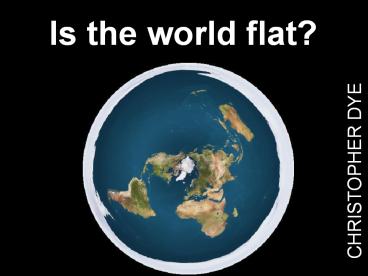Is the world flat? PowerPoint PPT Presentation
Title: Is the world flat?
1
Is the world flat?
CHRISTOPHER DYE
2
Is the world flat?
CHRISTOPHER DYE
3
(No Transcript)
4
Inequality a mean kind of variation
5
Twin peaks the unequal world
6
Berlin 9 November 1989
7
The Cold War's final frontier
Infant mortality/1000 North 42 South 6
Years lost to chronic illness () North 46 South
72
8
(No Transcript)
9
Friedman's flatteners
- 1 No boundaries
- 2 Netscape
- 3 Workflow software
- 4 Open sourcing
- 5 Outsourcing
- 6 Offshoring
- 7 Supply chaining
- 8 Insourcing
- 9 In-forming
- 10 Digital "Steroids"
10
Representing one's country?
11
Bangalore the poverty gradient runs steeply
down from Infosys
12
(No Transcript)
13
The Great Divergence, 1800-2000
- Growing differences in income per person arise
because - 1. Variable efficiency of production per worker
- 2. Medicine lowers subsistence wage
- 3. High technology raises wage premium for
skilled labour
14
The World is not Flat Inequality and
Injustice in our Global Economy Nancy Birdsall
"Inequality in developing countries stalls
economic growth vicious circles inhibit the
creation of effective social and political
institutions"
15
Gini a digression on measuring inequality
Gini index Equality 0 Inequality 1
Cumulative share earned
GINI
Cumulative share of people from low income
16
Gini out of the bottle
rich-poor income gap widening in most countries
10
8
6
4
Change in Gini (, 1990s-2000s)
2
0
-2
-4
-6
USA
India
Nepal
Brazil
China
Japan
Taiwan
S Korea
Viet Nam
Pakistan
Malaysia
Thailand
Germany
Indonesia
Cambodia
Philippines
17
Increasing inequality among countries
within different regions of the world
E Europe
OECD
S Asia
60
E Asia
SS Africa
L America
50
Income Gini
40
30
20
1970
1975
1980
1985
1990
1995
2000
18
Birdsall failing markets, failing health?
Income inequality without opportunity or
mobility, also Undermines public policy Inhibits
collective decision-making Disfavours those
without assets Raises costs for poor
19
The Bottom BillionPaul Collier
- 58 countries, mostly in Africa, persistently low
income, trapped by - Conflict 73
- Valuable natural resources 29
- Geography (landlocked) 30
- Bad governance 76
- Health at the mercy of economics?
20
Convergence, Period!
Xavier Sala-i-Martin
21
(No Transcript)
22
(No Transcript)
23
(No Transcript)
24
(No Transcript)
25
Health in anUnequal World
26
Life expectancy is converging in low-
and high-income countries
80
Low-middle income
High income
70
60
Life expectancy (years)
50
40
30
1960
1990
2002
27
Life expectancy increased most in Asia and
L America, least in Africa and OECD
1970-75
80
2000-05
70
Life expecancy at birth
60
50
40
OECD
SS Africa
East Asia
South Asia
Arab States
Lat America
Central Europe
28
Life expectancy
gains and losses worldwide since 1960
10
1960-1990
8
1990-2002
1900-1950
6
4
1850-1900
Years gained per decade
2
0
-2
-4
Britain
E Asia
S Asia
Eurasia
Mid East
SS Africa
L America
29
(No Transcript)
30
(No Transcript)
31
(No Transcript)
32
Gorbachev, Glasnost Green Cross "cultivating a
new sense of global interdependence"
33
(No Transcript)
34
(No Transcript)
35
(No Transcript)
36
(No Transcript)
37
Health in Unequal Britain
38
"Riven by class and no social mobility"
- The Guardian
- No change in 10 years of Labour
- rule
- 89 say they are judged by class
- Poll shows deep North-South
- gap
- North-south divide will narrow
- but not rich-poor gap
- Wide life expectancy gap
- between rich and poor
39
Variation in life expectancy in Englandfrom
northern uplands to southern lowlands
40
Smoking deaths are higher in northern
England and London
41
(No Transcript)
42
Obesity in Englandhighest in midlands and north
Lowest in London South east South west
43
(No Transcript)
44
Whitehall civil servants lower
grades die younger
45
"The attainment by all peoples of the highest
possible level of health"
46
Who wants to fix it?"a common consensus to
invest in the future"?
47
The post-war health agenda
- 1946 World Health Organization
- Marshall Plan
- UK National Health Service
(welfare state) - --------------------------------------------------
------ - 1950s "Vertical" eradication programs
- 1960s Barefoot doctors - community
- care
- 1978 Primary Health Care (Alma Ata)
- 1979 Children's Revolution
48
"Health for All"
- Halfdan Mahler (WHO 1978)
- Moral leadership for social justice
Primary Health Care Appropriate technology Care
in the community Link health and social
development
Critics too costly, politically threatening
49
"Children's Revolution"
- Jim Grant (UNICEF 1979)
- Finite resources, brief political opportunities
GOBI Growth monitoring Oral rehydration Breast
feeding Immunization
Critics narrowly technocentric
50
1980s the neo-liberal consensus
- "Health sector reform"
- limit public expenditure, decentralization,
economic efficiency - "Structural adjustment"
- trade liberalization, privatization of public
services, export economy
51
Clinical economicsThe end of poverty by 2025
- You two?
- "I am a Jeff Sachs groupie" (Bono)
52
Incentives William Easterly
53
Bottom Billion Paul Collier
"The grievous truth is that the bottom billion
will notand cannotbe freed from poverty in our
lifetimes."
- Targeted AID
- Military interventions
- Anti-corruption laws
- Concessional trade agreements
- Help your local hero
"international welfare for a long timeto bring
minimal decency to standards for living"
54
Technological fix Bill Gates
- World Economic Forum, Davos 2006
- Bill Gates pledges another 900m for TB control
55
Social fix Michael Marmot
56
The world is getting flatterbut deep troughs
remain
- Poverty gap -- inequality sometimes puts a
brake on economic growth, and on health gains - Health is getting better on average in most parts
of the world globalization? - Health gaps (life span) have narrowed with
poverty gaps, perhaps even faster but - Some countries and populations have been left
behind, mostly Africa - Technical solutions to promote health equality
easier than social and economic solutions

